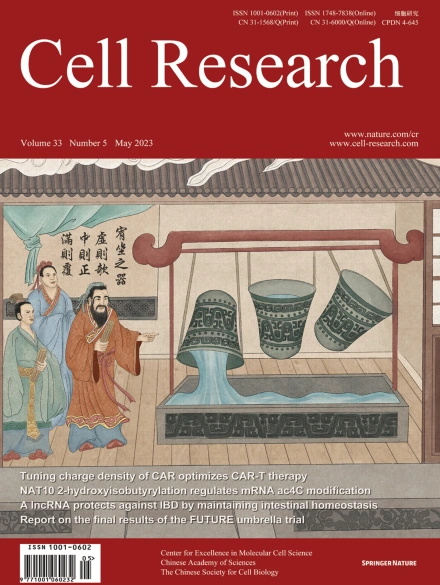
Advanced Search
Submit Manuscript
Advanced Search
Submit Manuscript
Volume 33, No 5, May 2023
ISSN: 1001-0602
EISSN: 1748-7838 2018
impact factor 17.848*
(Clarivate Analytics, 2019)
Volume 33 Issue 5, May 2023: 355-371
Lysine 2-hydroxyisobutyrylation of NAT10 promotes cancer metastasis in an ac4C-dependent manner
Long Liao1,2,† , Yan He1,2,† , Shu-Jun Li1,2,† , Xiao-Mei Yu1,2,† , Zhi-Chao Liu3,† , Yi-Yao Liang4 , Han Yang5 , Jing Yang1,2 , Guo-Geng Zhang1,2 , Chun-Miao Deng1 , Xian Wei1 , Yi-Dong Zhu1,2 , Tao-Yang Xu1,2 , Can-Can Zheng1 , Chao Cheng6 , Ang Li4 , Zhi-Gang Li3 , Jin-Bao Liu7 , Bin Li1,*
1Key Laboratory of Biological Targeting Diagnosis, Therapy and Rehabilitation of Guangdong Higher Education Institutes, State Key Laboratory of Respiratory Disease, The Fifth Affiliated Hospital of Guangzhou Medical University, Guangzhou, Guangdong, ChinPosttranslational modifications add tremendous complexity to proteomes; however, gaps remain in knowledge regarding the function and regulatory mechanism of newly discovered lysine acylation modifications. Here, we compared a panel of non-histone lysine acylation patterns in metastasis models and clinical samples, and focused on 2-hydroxyisobutyrylation (Khib) due to its significant upregulation in cancer metastases. By the integration of systemic Khib proteome profiling in 20 paired primary esophageal tumor and metastatic tumor tissues with CRISPR/Cas9 functional screening, we identified N-acetyltransferase 10 (NAT10) as a substrate for Khib modification. We further showed that Khib modification at lysine 823 in NAT10 functionally contribute to metastasis. Mechanistically, NAT10 Khib modification enhances its interaction with deubiquitinase USP39, resulting in increased NAT10 protein stability. NAT10 in turn promotes metastasis by increasing NOTCH3 mRNA stability in an N4-acetylcytidine-dependent manner. Furthermore, we discovered a lead compound #7586-3507 that inhibited NAT10 Khib modification and showed efficacy in tumor models in vivo at a low concentration. Together, our findings bridge newly identified lysine acylation modifications with RNA modifications, thus providing novel insights into epigenetic regulation in human cancer. We propose that pharmacological inhibition of NAT10 K823 Khib modification constitutes a potential anti-metastasis strategy.
https://doi.org/10.1038/s41422-023-00793-4